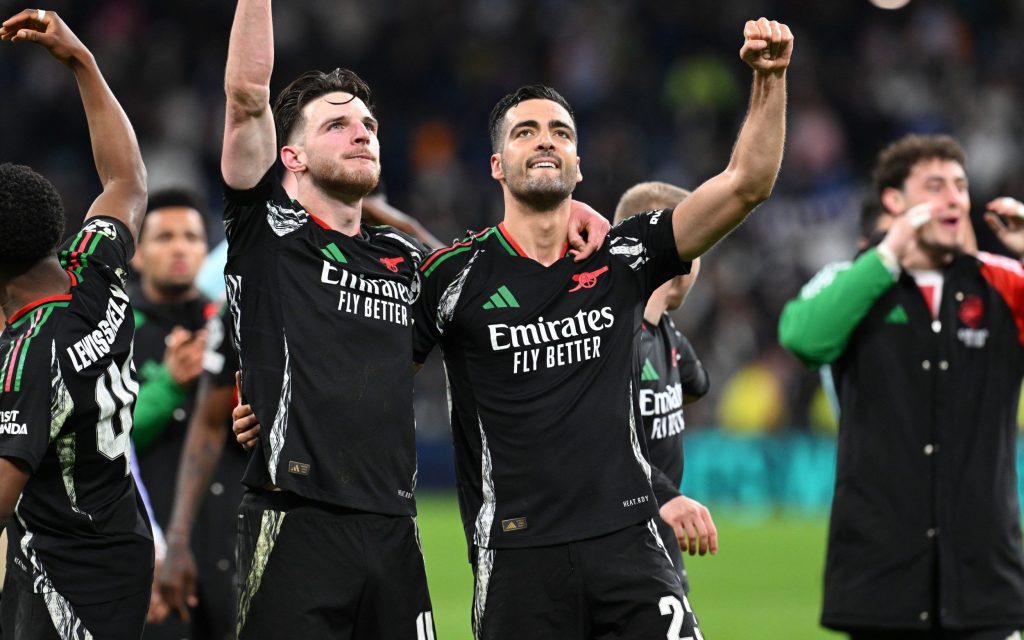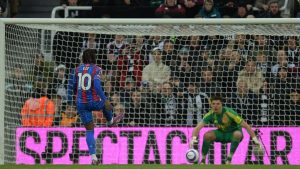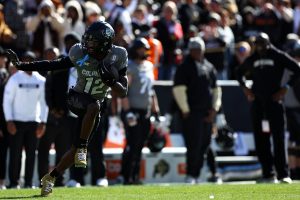
Any victory against Real Madrid would have been cause for Arsenal celebration, but comprehensively dismantling the Champions League holders provides additional satisfaction for Mikel Arteta and his players.
Even the most fervent and one-eyed Madridista could not not cry foul after two legs in which they were bettered in every department by a combative, slick and street-wise Arsenal team.
It means Arsenal have won three and drawn one of four European Cup meetings against Madrid, a curious record considering the two clubs’ respective records in the competition.
Madrid were missing three of their first-choice back four, but Arsenal also achieved their 5-1 aggregate win without first-choice defender Gabriel and centre-forward Kai Havertz. Teenager Myles Lewis-Skelly was at left-back with Jakub Kiwior, possibly not even third-choice at left centre-back partnering William Saliba.
This is how Arsenal mastered Madrid across both games.
Play through Real with ease at home
The first phase of build-up play, and the opposition’s pressing structure against it, is a key battle in every elite game in today’s game. Just look how many goals are scored from high turnovers, or conversely, chances created after a team has been drawn on and the press bypassed.
With the exception of William Saliba’s error in the second leg, Arsenal found it very easy to play through or around the first line of Madrid’s defence. These structural problems have been evident in La Liga all season, with Vinicius Junior and Kylian Mbappé half-interested in their defensive responsibility.
David Raya was key to exposing this problem, with the Arsenal goalkeeper splitting Saliba and Kiwior to make a three-on-two against the Madrid forwards. If Mbappé and Vinicius sneaked towards the centre-backs, a gap opened up for Raya to thread the ball into Thomas Partey or Lewis-Skelly who were positioned behind them.
That is exactly what happened in the build-up to Mikel Merino’s goal in the home game. Raya fired a pass into Lewis-Skelly. That means Madrid midfielder Federico Valverde has a choice to make about whether to jump towards Lewis-Skelly or Partey, knowing that Merino and Martin Odegaard are behind him (you can see the leg of Merino on the left of the above picture).
With so many bodies overloading Madrid centrally, Rice (bottom of the screen) is free to drop wide and drive Arsenal forward.
A best of both defensive approach
It takes courage to press Madrid high with the speed they possess at the top of the pitch, but Arsenal picked their moments to do it.
Naturally, this happened more at the Emirates and was usually prompted by certain triggers such as the ball being on Antonio Rüdiger’s left foot or a loose touch from a Madrid player. With Toni Kroos now departed, Madrid are lacking in deep distributors who can dictate. Rüdiger is not a ball-playing defender and Thibaut Courtois does not excel with his feet.
When Madrid had more comfortable possession, Arsenal respected their attacking threat and dropped deeper into their now familiar 4-4-2 defensive shape. We saw more of this in Wednesday’s second leg.
There was particular responsibility on Rice and Partey to keep an eye on the movements of Jude Bellingham depending on which side of the pitch he drifted towards. Even when Bellingham did make a burst into the box, Rice was there to make a crucial tackle.
Attacking from side to side
Square passes can be a symptom of horseshoe attacks and sterile possession, as Arsenal well know, but in both legs against Madrid, Arsenal found joy moving the ball from left to right and back again.
Madrid’s defensive shape was often completely lop-sided, with Arsenal finding it too easy to work the ball off the touchline into a spare man in the middle of the pitch.
The move for Merino’s goal at the Emirates was one such move, with Arsenal zig-zagging across the pitch in a 16-pass move.
16 – Arsenal’s third goal against Real Madrid was scored following a 16-pass move which began with David Raya; the second-longest goal sequence initiated by a goalkeeper in the #UCL this season. Elaboration. pic.twitter.com/4Eqy0ImV1C
— OptaJoe (@OptaJoe) April 9, 2025
Saka’s goal in Madrid started with Merino winning a flick-on down the right. The Madrid players were dragged over in an effort to stifle Saka, but when Arsenal found a way out, there was so much space for Odegaard and Merino in the other half of the pitch.
Saka made a Freddie Ljungberg-style run across the Real back line and lifted the ball over Courtois to score the goal that put the tie beyond doubt. There were countless other examples of Arsenal being close to the touchline one minute and then in wide open space centrally the next, before pushing the ball to the other flank.
ARSENAL HAVE THEIR GOAL! ⚽
Bukayo Saka keeps his composure as he lifts the ball over Courtois 🥶
📺 @tntsports & @discoveryplusUKpic.twitter.com/RvGxtgl3EB
— Football on TNT Sports (@footballontnt) April 16, 2025
The set-piece balance sheet
Madrid struggled to create chances from open play, but they did have 13 corners across both legs and failed to make any of them count. They barely threatened in fact, and the same was true of wide free-kicks. Raya punched and claimed their deliveries with assurance and Real suffered from a lack of physicality in the opposing penalty.
By contrast, as is familiar in the Premier League, Arsenal were menacing from corners in the first leg, with Courtois palming one off the line and Saliba preventing his team-mate Partey scoring with a glancing header. The penalty they won in Madrid, missed by Saka with his failed Panenka, came from the panic Madrid’s defenders felt at corners with Raúl Asencio dragging down Merino.
Of course, Rice’s two free-kicks were two more Arsenal set-piece goals, although more aesthetically pleasing than most of them. Any excuse to watch Rice’s two efforts again.
DECLAN RICE WITH A MOMENT OF MAGIC 🪄
An excellent free kick from the Arsenal midfielder see’s the host go in front#UCLonPrimepic.twitter.com/Vopmz8aCUZ
— Amazon Prime Video Sport (@primevideosport) April 8, 2025
DECLAN RICE HAS DONE IT AGAIN 🤯
Another excellent free kick puts Arsenal up 2-0 at the Emirates#UCLonPrimepic.twitter.com/xXezgRvfJq
— Amazon Prime Video Sport (@primevideosport) April 8, 2025
Dominating the flanks
Saka made his first start following hamstring surgery in the first leg, and despite being undercooked, he had the beating of David Alaba all night. That continued in Spain, where Alaba appeared scared stiff of his opponent and hacked Saka down at the expense of a yellow card early on.
It was harder going for Gabriel Martinelli against Valverde, but his time to shine came against Lucas Vázquez in the second leg. Martinelli showed some neat touches, including one nutmeg in the second half on Endrick, and scored Arsenal’s breakaway winner on the night.
Jurrien Timber’s showing against Vinicius will go down in Arsenal folklore though, and win acclaim across Europe. He shut down one of the most dangerous wingers in the world with a superb display of one-on-one defending, showing the Brazilian the outside and then recovering to block countless crosses.
On the other flank, Lewis-Skelly’s ridiculous composure in possession helped Arsenal prevent waves of Madrid attacks by winning fouls, breaking lines and picking clever passes rather than hoofing the ball away. Rodrygo is probably the weak link in Madrid’s front three, but he was still anonymous against an 18-year-old.
Repelling Real’s crosses
Madrid’s only attacking tactic in the second leg was to pepper the Arsenal box with crosses, which seemed a strange approach against a team with a strong back four and goalkeeper. Real Madrid sent 42 crosses into the box, only seven of which were successful.
Arsenal filled the penalty box with bodies, with the height of midfielders Partey and Rice buttressing this area. Even nominal centre-forward Merino was working back to win headers on the edge of his own box.
Engaging in dark arts of their own
Arsenal were streetwise in the second leg in Madrid, slowing the game down when the time was right. Raya was booked for time-wasting, and Arsenal effectively played for throw-ins and territory early in the game to quell any Madrid storm. They were also very effective at winning fouls, 15 in all at the Santiago Bernabéu. There were 33 overall in the game, and that led to a stop-start rhythm which suited the team with a three-goal lead. Timber, Lewis-Skelly and Saka were particularly effective at getting their body between man and ball to win free-kicks.
It was a small thing, and the correct decision in the end, but Arsenal’s vociferous response to the penalty awarded to Real Madrid may also have played a part in making sure VAR took a close look at the incident involving Rice and Mbappé.

Any victory against Real Madrid would have been cause for Arsenal celebration, but comprehensively dismantling the Champions League holders provides additional satisfaction for Mikel Arteta and his players.
Even the most fervent and one-eyed Madridista could not not cry foul after two legs in which they were bettered in every department by a combative, slick and street-wise Arsenal team.
It means Arsenal have won three and drawn one of four European Cup meetings against Madrid, a curious record considering the two clubs’ respective records in the competition.
Madrid were missing three of their first-choice back four, but Arsenal also achieved their 5-1 aggregate win without first-choice defender Gabriel and centre-forward Kai Havertz. Teenager Myles Lewis-Skelly was at left-back with Jakub Kiwior, possibly not even third-choice at left centre-back partnering William Saliba.
This is how Arsenal mastered Madrid across both games.
Play through Real with ease at home
The first phase of build-up play, and the opposition’s pressing structure against it, is a key battle in every elite game in today’s game. Just look how many goals are scored from high turnovers, or conversely, chances created after a team has been drawn on and the press bypassed.
With the exception of William Saliba’s error in the second leg, Arsenal found it very easy to play through or around the first line of Madrid’s defence. These structural problems have been evident in La Liga all season, with Vinicius Junior and Kylian Mbappé half-interested in their defensive responsibility.
David Raya was key to exposing this problem, with the Arsenal goalkeeper splitting Saliba and Kiwior to make a three-on-two against the Madrid forwards. If Mbappé and Vinicius sneaked towards the centre-backs, a gap opened up for Raya to thread the ball into Thomas Partey or Lewis-Skelly who were positioned behind them.
That is exactly what happened in the build-up to Mikel Merino’s goal in the home game. Raya fired a pass into Lewis-Skelly. That means Madrid midfielder Federico Valverde has a choice to make about whether to jump towards Lewis-Skelly or Partey, knowing that Merino and Martin Odegaard are behind him (you can see the leg of Merino on the left of the above picture).
With so many bodies overloading Madrid centrally, Rice (bottom of the screen) is free to drop wide and drive Arsenal forward.
A best of both defensive approach
It takes courage to press Madrid high with the speed they possess at the top of the pitch, but Arsenal picked their moments to do it.
Naturally, this happened more at the Emirates and was usually prompted by certain triggers such as the ball being on Antonio Rüdiger’s left foot or a loose touch from a Madrid player. With Toni Kroos now departed, Madrid are lacking in deep distributors who can dictate. Rüdiger is not a ball-playing defender and Thibaut Courtois does not excel with his feet.
When Madrid had more comfortable possession, Arsenal respected their attacking threat and dropped deeper into their now familiar 4-4-2 defensive shape. We saw more of this in Wednesday’s second leg.
There was particular responsibility on Rice and Partey to keep an eye on the movements of Jude Bellingham depending on which side of the pitch he drifted towards. Even when Bellingham did make a burst into the box, Rice was there to make a crucial tackle.
Attacking from side to side
Square passes can be a symptom of horseshoe attacks and sterile possession, as Arsenal well know, but in both legs against Madrid, Arsenal found joy moving the ball from left to right and back again.
Madrid’s defensive shape was often completely lop-sided, with Arsenal finding it too easy to work the ball off the touchline into a spare man in the middle of the pitch.
The move for Merino’s goal at the Emirates was one such move, with Arsenal zig-zagging across the pitch in a 16-pass move.
16 – Arsenal’s third goal against Real Madrid was scored following a 16-pass move which began with David Raya; the second-longest goal sequence initiated by a goalkeeper in the #UCL this season. Elaboration. pic.twitter.com/4Eqy0ImV1C
— OptaJoe (@OptaJoe) April 9, 2025
Saka’s goal in Madrid started with Merino winning a flick-on down the right. The Madrid players were dragged over in an effort to stifle Saka, but when Arsenal found a way out, there was so much space for Odegaard and Merino in the other half of the pitch.
Saka made a Freddie Ljungberg-style run across the Real back line and lifted the ball over Courtois to score the goal that put the tie beyond doubt. There were countless other examples of Arsenal being close to the touchline one minute and then in wide open space centrally the next, before pushing the ball to the other flank.
ARSENAL HAVE THEIR GOAL! ⚽
Bukayo Saka keeps his composure as he lifts the ball over Courtois 🥶
📺 @tntsports & @discoveryplusUKpic.twitter.com/RvGxtgl3EB
— Football on TNT Sports (@footballontnt) April 16, 2025
The set-piece balance sheet
Madrid struggled to create chances from open play, but they did have 13 corners across both legs and failed to make any of them count. They barely threatened in fact, and the same was true of wide free-kicks. Raya punched and claimed their deliveries with assurance and Real suffered from a lack of physicality in the opposing penalty.
By contrast, as is familiar in the Premier League, Arsenal were menacing from corners in the first leg, with Courtois palming one off the line and Saliba preventing his team-mate Partey scoring with a glancing header. The penalty they won in Madrid, missed by Saka with his failed Panenka, came from the panic Madrid’s defenders felt at corners with Raúl Asencio dragging down Merino.
Of course, Rice’s two free-kicks were two more Arsenal set-piece goals, although more aesthetically pleasing than most of them. Any excuse to watch Rice’s two efforts again.
DECLAN RICE WITH A MOMENT OF MAGIC 🪄
An excellent free kick from the Arsenal midfielder see’s the host go in front#UCLonPrimepic.twitter.com/Vopmz8aCUZ
— Amazon Prime Video Sport (@primevideosport) April 8, 2025
DECLAN RICE HAS DONE IT AGAIN 🤯
Another excellent free kick puts Arsenal up 2-0 at the Emirates#UCLonPrimepic.twitter.com/xXezgRvfJq
— Amazon Prime Video Sport (@primevideosport) April 8, 2025
Dominating the flanks
Saka made his first start following hamstring surgery in the first leg, and despite being undercooked, he had the beating of David Alaba all night. That continued in Spain, where Alaba appeared scared stiff of his opponent and hacked Saka down at the expense of a yellow card early on.
It was harder going for Gabriel Martinelli against Valverde, but his time to shine came against Lucas Vázquez in the second leg. Martinelli showed some neat touches, including one nutmeg in the second half on Endrick, and scored Arsenal’s breakaway winner on the night.
Jurrien Timber’s showing against Vinicius will go down in Arsenal folklore though, and win acclaim across Europe. He shut down one of the most dangerous wingers in the world with a superb display of one-on-one defending, showing the Brazilian the outside and then recovering to block countless crosses.
On the other flank, Lewis-Skelly’s ridiculous composure in possession helped Arsenal prevent waves of Madrid attacks by winning fouls, breaking lines and picking clever passes rather than hoofing the ball away. Rodrygo is probably the weak link in Madrid’s front three, but he was still anonymous against an 18-year-old.
Repelling Real’s crosses
Madrid’s only attacking tactic in the second leg was to pepper the Arsenal box with crosses, which seemed a strange approach against a team with a strong back four and goalkeeper. Real Madrid sent 42 crosses into the box, only seven of which were successful.
Arsenal filled the penalty box with bodies, with the height of midfielders Partey and Rice buttressing this area. Even nominal centre-forward Merino was working back to win headers on the edge of his own box.
Engaging in dark arts of their own
Arsenal were streetwise in the second leg in Madrid, slowing the game down when the time was right. Raya was booked for time-wasting, and Arsenal effectively played for throw-ins and territory early in the game to quell any Madrid storm. They were also very effective at winning fouls, 15 in all at the Santiago Bernabéu. There were 33 overall in the game, and that led to a stop-start rhythm which suited the team with a three-goal lead. Timber, Lewis-Skelly and Saka were particularly effective at getting their body between man and ball to win free-kicks.
It was a small thing, and the correct decision in the end, but Arsenal’s vociferous response to the penalty awarded to Real Madrid may also have played a part in making sure VAR took a close look at the incident involving Rice and Mbappé.










